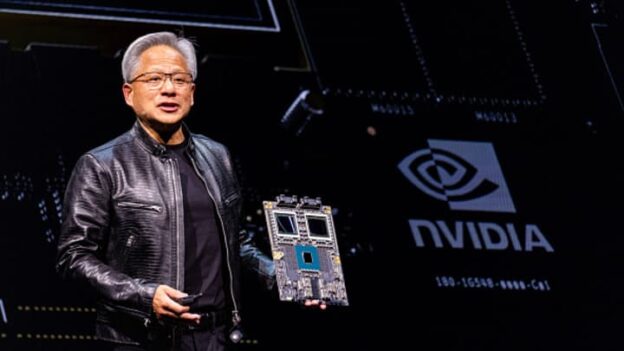How long will the strong artificial intelligence buildout last? The market appears optimistic, with AI chip leader Nvidia (NASDAQ: NVDA) trading at 34 times forward earnings estimates and challenger Advanced Micro Devices (NASDAQ: AMD) trading at 30 times.
However, there is a considerable debate among investors as to whether this hypergrowth is sustainable, or whether the AI buildout is going to pop like the dot-com bust.
This week, CEOs of AI chip leaders Nvidia and AMD made announcements, each of which gave even greater weight to the bull case for their stocks and AI chips stocks generally.
Bulls vs. bears on AI
AI stocks pulled back hard over the summer after a strong 18 months or so of performance, as skepticism worked its way into the story. After the Magnificent Seven, who are the main buyers of AI chips, reported good but not blowout earnings in July, investors appeared concerned that these big chip buyers weren’t seeing a requisite return on their investments in Nvidia chips. Most big tech stocks and AI chip plays sank in response.
Giant hedge fund Elliott Management piled onto the skepticism, giving especially bearish commentary on what it perceives as an AI “bubble.” Elliott wrote in its latest letter to investors that AI stocks were overhyped, declaring AI applications aren’t, “ever going to be cost-efficient, are never going to actually work right, will take up too much energy, or will prove to be untrustworthy.” Elliott dismissed the technology as only good for a few things such as summarizing reports and helping with computer coding.
That’s certainly a point of view that should be considered. It may even be true of the current models that are out today. However, virtually everyone participating in the technology industry believes in the benefits. If benefits weren’t likely going to be there, it seems unlikely every major technology company would be greatly expanding its AI investments today as they are.
For his part, Oracle Chairman Larry Ellison dismissed these concerns, declaring the race for AI supremacy “goes on forever, to build a better and better neural network.” Ellison believes that AI capabilities will improve with more compute and better models, and that the large tech companies can’t afford to cede the AI lead to competitors. With big tech armed with a ton of cash, he doesn’t see the buildout ending for five to 10 years.

Jensen Huang and Lisa Su just dropped the mic
This week then saw two massive announcements from the number one and two AI chip companies that should allay near-term fears about the durability of the AI trade. At the beginning of the month, Nvidia’s CEO Jensen Huang said demand for its next generation chip Blackwell was “insane.” Fast forward to last week, and analysts at Morgan Stanley revealed Blackwell is already sold out for the next 12 months, after the firm hosted Nvidia executives at their offices.
Then on Thursday, AMD held its “Advancing AI” event during which it unveiled its new EPYC 9005 CPUs and Instinct MI325X GPUs. During the presentation, CEO Lisa Su increased her projection for the market size for AI accelerators. Last year, Su surprised investors by forecasting the AI accelerator market would increase from $45 billion in 2023 to a whopping $400 billion in 2027.
So, has the past year made her more skeptical or anxious about all that spend, as Elliott surmises?
Just the opposite, in fact. During the conference, Su raised her guidance for the AI accelerator market to reach a whopping $500 billion by 2028, saying, “Since [last year], AI demand has continued to take off and exceed expectations. It’s clear that the rate of investment is continuing to grow everywhere, driven by more powerful models, new use cases, and actually just a wider adoption of AI use cases.”
If Su’s and Huang’s projections hold, more companies will benefit than just Nvidia and AMD. Any company with a strong competitive position in the related foundry, semicap equipment, server, or AI-integrated software industries should also see a benefit from this medium-term demand. Additionally, electricity and transmission providers should also see strong growth, as AI data centers consume a huge amount of energy.
Bubble brewing? Not just yet
While the dot-com bubble burst in the year 2000, remember that there was a five-year “boom” that preceded it. The boom coincided with the period after the Federal Reserve cut interest rates between 1995 through 1998. Looking at today’s situation, the AI boom is only about two years old, and the Fed similarly just began a rate-cutting cycle in September.
To this investor, it appears we may be more in the “mid-90s” analogy rather than the precipice of an enormous bubble bursting. There’s also a case for the boom to go on for a longer time than the internet boom did, as the companies investing AI, the Mag Seven, are all extremely strong financially — much stronger than a lot of the newer start-up tech companies of the mid-1990s. In addition, for all their success, the Mag Seven really don’t trade at the crazy valuations seen by big tech in the late 1990s.
That doesn’t mean the AI buildout couldn’t become a bubble — it could. But it still seems early, and AI stocks are too reasonably priced for a huge fall, barring any outside exogenous shocks.
https://finance.yahoo.com/news/nvidia-advanced-micro-devices-just-091100386.html





